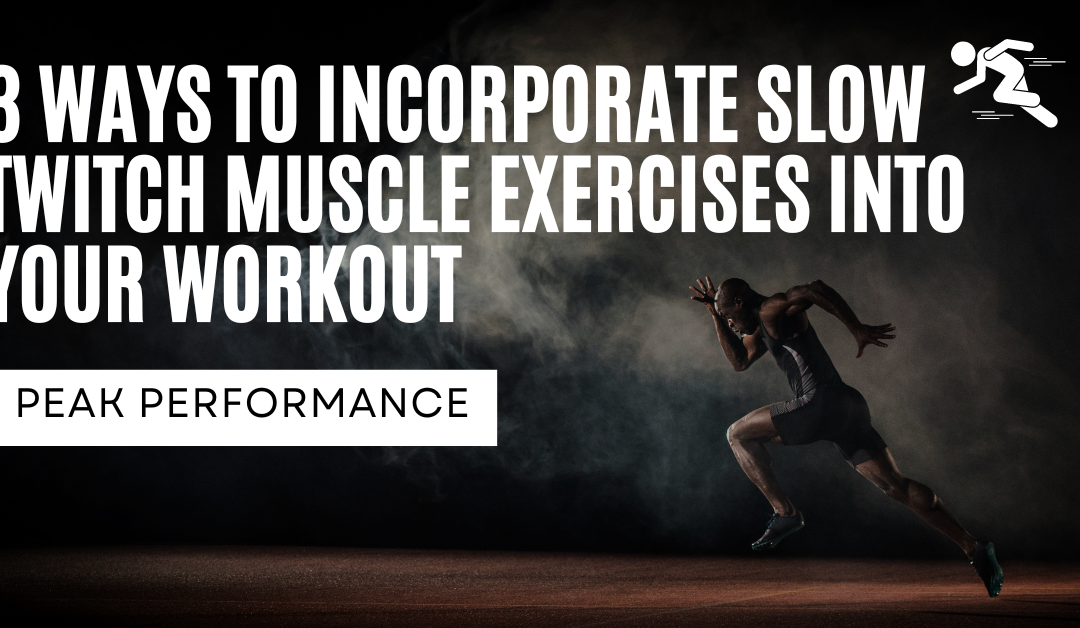Slow twitch muscle exercises are crucial for endurance athletes, and many studies show that endurance athletes actually have more slow-twitch vs fast-twitch fibers.
Why?
Endurance athletes train with:
- Low resistance
- High reps
It’s no secret that if you want to run a marathon, you need endurance. Slow-twitch fibers use lower energy levels than fast-twitch fibers, and they allow you to reach the last mile of a triathlon or have the energy to hike six miles without breaking a sweat.
Why?
Slow-twitch fibers use mitochondria for energy and provide their own source of energy. If you need to do any activity for a lengthy period of time, the fibers’ ability to create its own energy is going to be crucial to your success.
We’re going to cover exactly how to perform these exercises and a few that you should incorporate into your workout routine.
What You Need to Know Before Focusing on Slow-Twitch Muscle Exercises
Before we go into specific exercises to engage these muscle fibers, it’s important to know a few things:
- Body-weight exercises work very well to improve the concentration of slow twitch fibers
- Resistance training can also hit these muscle fibers, but you will want to focus on high reputations for aerobic metabolism, which is a fancy way of saying keep your reps at least 15 or higher
- Rest periods should be kept low, in the 30-second range, because you won’t need the lengthy rest period required to replenish ATP energy
- Weight, if you’re using resistance, should be no more than 50% of your one rep max, unless you can do a higher percentage for 15+ reps
You can incorporate cheat exercises when trying to reach higher reps, such as 30 or more. However, you do want to be cautious of your form because some exercises can cause injury even if you’re using a much lower weight than you can handle on a typical day.
Worth Reading
We’ve dived into slow and fast twitch muscle fibers quite a bit on this site, and we have a few articles that you may want to read to educate yourself further on this topic:
- Guide to fast-twitch vs slow-twitch muscle fibers
- Guide on power vs. endurance vs. strength workouts
- Guide on fast twitch muscle exercises
Finally, let’s see some examples of slow twitch muscle exercises so that you can begin incorporating them into your routine.

3 Ways to Incorporate Slow Twitch Muscle Exercises Into Your Workout
1. Low Weight, High Reps
Lifting weights, using bands or any type of resistance training, can be modified to focus primarily on these muscle fibers. However, you have to consider the type of exercise you perform, too.
Complex movements often engage both fast- and slow-twitch fibers.
The key to building up these fibers with resistance training is:
- High reps of 15+
- Sets of 3+
- Rest of 30 seconds or less
You don’t want to perform explosive reps out of fear that you’ll engage more type II fibers. Instead, slow, controlled and volume are what you want to focus on here for proper muscle fiber engagement.
If you want to be the best athlete you can be, you’ll find that these types of exercises and an endurance workout plan will help round out your fitness.
2. Burnout Sessions
Burnout sessions are going to be questionable for a lot of people reading this article because you’ll work on both types of muscle fibers. For example, you may do the following:
- 4 sets of 8 seated rows
- 1 set of X seated rows to burnout
You can do this with any exercise, such as shoulder press, bench press, deadlift or any other that you see fit.
When you’re done with your “strength” training, you’ll lower the weight and perform as many reps as you can until you reach failure.
Burnouts are performed by doing one exercise at the end of a workout.
For example, you may burnout with rows as your last exercise on back day. However, you can do the same with your biceps, triceps – any muscle. But, you also want to be sure that you use precaution to not cause injury on the final reps.
Someone burning out with squats, for example, will want someone to spot them to ensure that they don’t collapse at the end or can’t get up from the squat.
Something to Remember
Performing high reps will often help you finish your workout faster. You won’t need to spend time warming up before a workout and the 30-second rest period allows you to fly through your workout.
But if you’re burning out, meaning that you do moderate or heavy weight at some point during your workout, you do want to warm up beforehand.
3. Cardio Sessions
Cardio, and sprinting specifically, is one of the most studied areas of slow-twitch muscle. A great study on this subject found that during 13 weeks of marathon training, and a three-week tapering period:
- Type I muscle fibers increased from 42.6% to 48.6%
- Type IIa fibers decreased from 40.1% to 35.8%
It’s crucial to note that researchers focused on novice runners because they wouldn’t have the same higher ratio of type I fibers as someone who runs marathons often. In fact, it’s hypothesized that if you already have a large concentration of type I or II fibers, it may be difficult to build more.
Again, the main switch in routine for cardio was to gravitate towards high volume work.
For example, let’s assume that you’re running 1-mile per day.
If you want to focus solely on the slow-twitch muscles, you’ll want to increase this to 2, 3, 4, or more miles a day, thus adding more volume. You don’t want to add resistance, so you’ll avoid focusing on hills or wearing a weighted vest.
The same goes for a cardio machine.
You’ll want to focus on distance without adding in resistance or an incline, which will engage more muscles and add to your type II muscle fibers instead.
Note: Cardio sessions should not include sprints. Why? These explosive sprints will lead to you engaging your fast-twitch muscles. Instead, maintain a steady pace for as long as you can to reach your goal.
Slow twitch muscle exercises may not seem as “impressive” as building mass or hitting a new PR, but they’re crucial to your overall fitness level.

